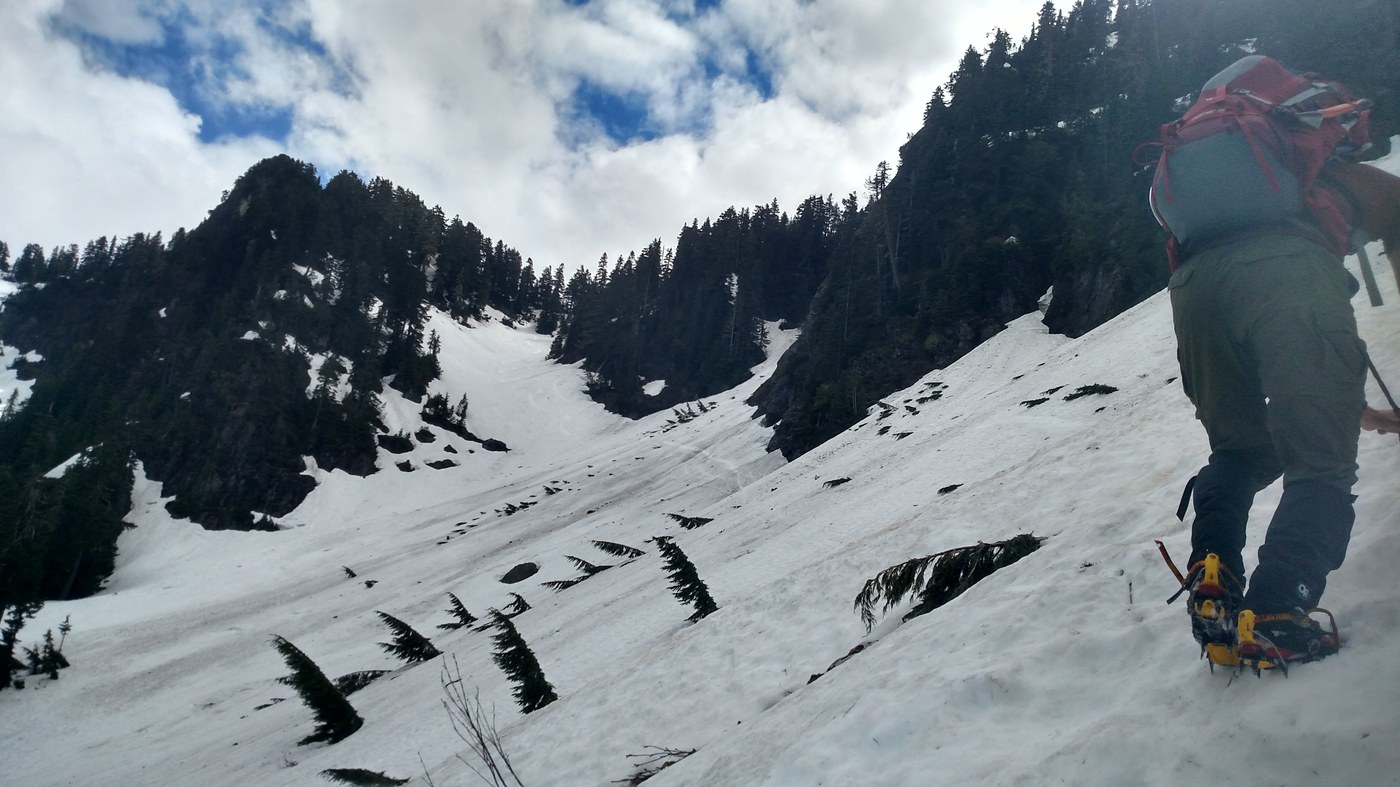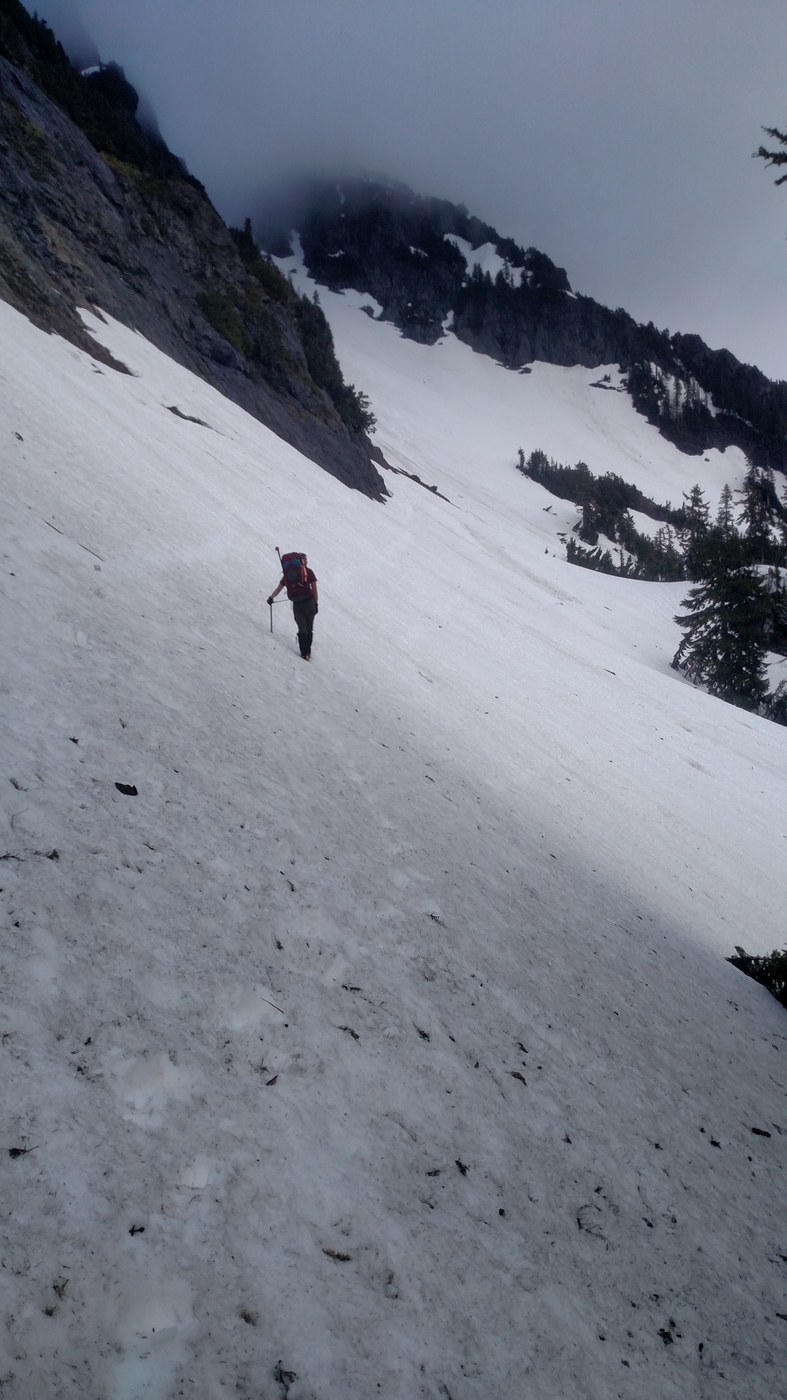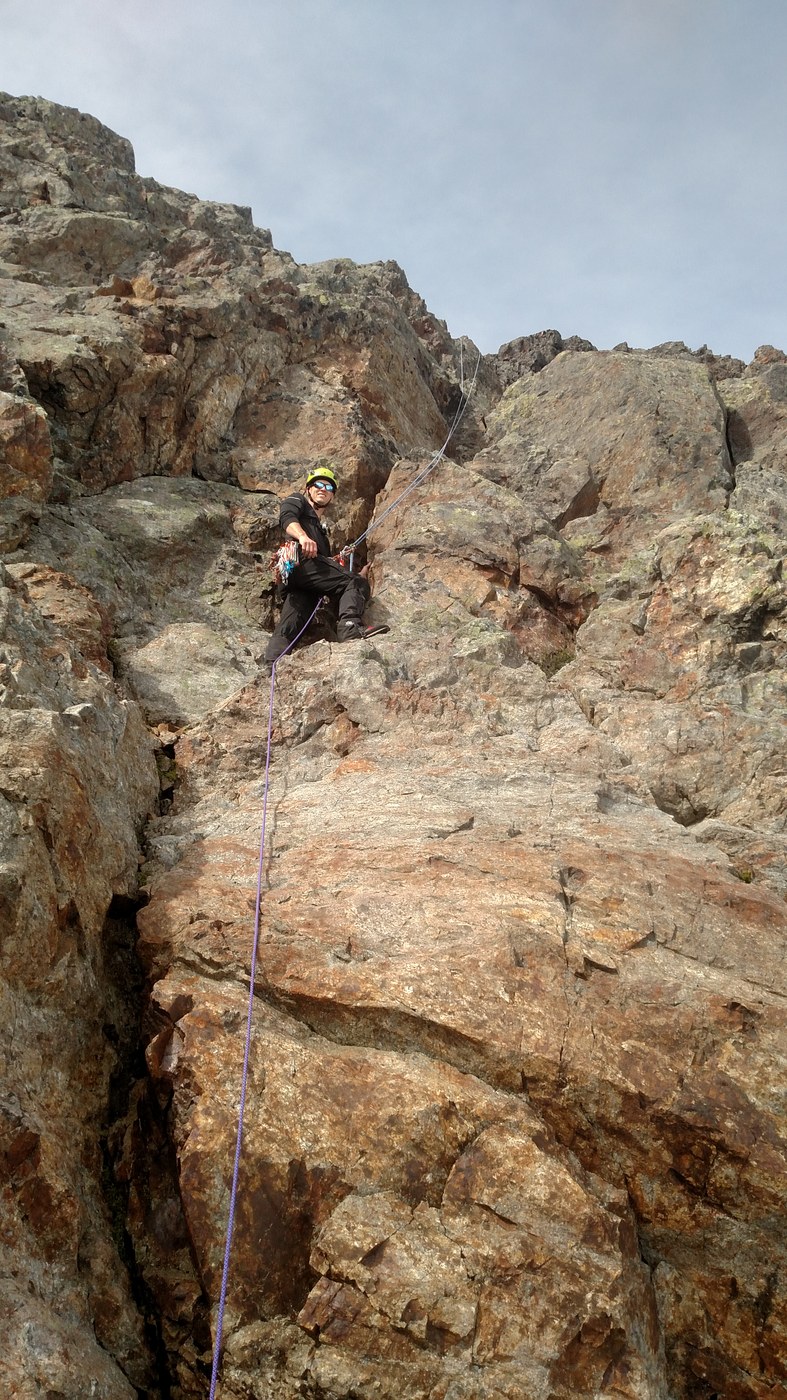Two day hike/climb of Whitehorse. One of the iconic peaks of the Mountain Loop region. It is impossible to miss Whitehorse from Hwy 530 as it stands high above the town of Darrington.
The trail starts out easily enough on an old closed gravel road bed that is slowly being eroded by a stream. Narrow in places because of overgrown bushes it is easy to follow and leads you a mile or so to the actual start of the trail at a reader board and trail register.
The start of the trail is the start of the switchbacks. Still easy to follow but overgrown and with plenty of blown down trees. The elevation gain is steady and unrelenting with somewhere around 26-30 switchbacks. The switchbacks and the discernible trail come to end but there is still plenty of overgrown forest to climb through. From here you just head up the slope. Devils club provides tempting if immediately regrettable handholds. Occasional pieces of colored tape help reassure you that you're on the right track but there is no marked trail. We went fairly long intervals without seeing pieces of tape but just keep heading up. It is steep and you'll probably be using your hands in places.
Eventually you'll progress up to a more thinly forested area, this is where the snow started for us and would continue for the rest of the trip. We circled right around the first rock face we came to, get above it and begin the traverse towards Lone Tree Pass. Upon reaching the pass follow the ridge for a bit before descending the far side. We probably got off the correct"trail" here because we descended about 500 feet, most of the way to the frozen over pond. This was another steep forested section both coming and going. On our way towards the mountain we broke out the rope and rappelled a short section.
From the pond we started gaining back ground as you traverse and ascend south east towards high pass. We climbed into the clouds as we reached high pass and set up camp.
We woke up to the shining sun in the morning and some awesome views. With the cloud layer thousands of feet below us we had clear views to surrounding peaks and the summit of Whitehorse. Taking our packs with just water, snacks and climbing gear we traversed and climbed the obvious route up to the summit block. This late in the year there was no chance of staying on snow up to the summit itself with a very large moat all the way around the rock. I know there is supposed to be a class 3 scramble route up the rock but we were unable to see anything resembling that. We chose the easiest looking crack system and roped up.
My friend, a more experienced rock climber than I, led the pitch. We had not planned on a climb like this so had brought only a couple ice screws (useless) and 1 set of nuts for protection. We climbed while wearing our mountaineering boots. He got one small nut in about halfway up but was unprotected for most of the climb. A few large cams would have been best to protect the pitch. I followed up the approximately 25m pitch and stepped onto the summit ridge. A short scramble to the highest point and we stood on top in the sun with the clouds still well below us. I found and marked the summit register. We had clear views of all of the high peaks stretching from Baker down to Rainier. The lookout on top of Three fingers was just barely visible to my naked eye across the valley.
(If you're planning on going up the mountain could you take a few 4x6 notebook sheets to add to the register, the sheets there are full. Thanks)
After a rest and some photos we rappelled down to our packs and began the trip back to our tent. We followed our approach route for the most part with small deviations for what looked like slightly less steep terrain. The descent from the top of the forest down to the highest switchback was pretty miserable.
The slopes we crossed were mostly 35-40 degrees with the slope right below the summit being the steepest at 45-50. There is no trail for most of the route so be comfortable navigating. We both had compasses, I had a map and GPS and my friend had screen shots of other peoples trail descriptions. The GPS was useful for seeing fine contour lines and picking out the path of least resistance. I think we spent approximately 7.5 hours moving to reach the summit and about 4.5 on the descent. Total distance was about 15.7 miles with 7400 feet climbed to reach the summit, we lost and had to regain about 500 after Lone Tree Pass.







Comments
CassieCassidy on Whitehorse Mountain, Neiderprum Trail
Great report, and LOVE the video
Posted by:
CassieCassidy on Jun 19, 2017 02:02 PM
Cassie Lowry Edmark on Whitehorse Mountain, Neiderprum Trail
Thank so for the beta, guys! Added paper to the register. The moat is massive, we barely made it across. Any later in the season and it's unlikely to reach the summit. Much of the snow on the approach below the high pass is melting out so the trip is becoming more cumbersome as well.
Posted by:
Cassie Lowry Edmark on Jul 10, 2017 04:29 PM
Cassie Lowry Edmark on Whitehorse Mountain, Neiderprum Trail
Also, left webbing and cordalette above the line you climbed as our rap station - single rap ring though so I don't recommend too much use. The webbing on the summit station is looking thin too. Anyone going up should bring their own anchor building supplies at this point, consider 2 rap rings.
Posted by:
Cassie Lowry Edmark on Jul 10, 2017 04:33 PM